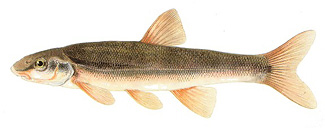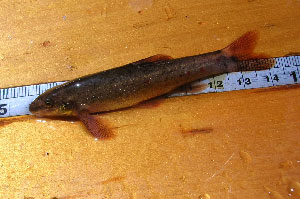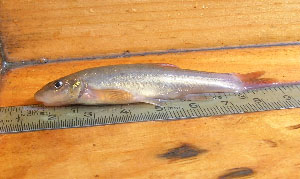Longnose Dace
Rhinichthys cataractae
 Distribution: Longnose dace are the most widely distributed minnow species in North America. They inhabit most of Canada, from the Arctic Circle south through the Rocky Mountains into Mexico and along the east coast to the southern Appalachian Mountains. They are found in all major watersheds of New Hampshire.
Distribution: Longnose dace are the most widely distributed minnow species in North America. They inhabit most of Canada, from the Arctic Circle south through the Rocky Mountains into Mexico and along the east coast to the southern Appalachian Mountains. They are found in all major watersheds of New Hampshire.
Description: A streamlined minnow with an elongated snout that projects over a sucker-like mouth. Coloration ranges from dark brown to light tan, often mottled or speckled in appearance, with a white to yellowish underbelly. Although some individuals may have a faded black lateral band, it is usually not as pronounced as that of the blacknose dace. The fins of breeding males may have a reddish tinge.
Species Commonly Confused With: Blacknose dace
Habitat: Longnose dace inhabit swift flowing riffle sections of rivers and streams with boulder, cobble, and gravel substrate.
Life History: The streamlined shape and small air bladders of longnose dace make them well adapted to living along the bottom in flowing water. They feed on invertebrates in the crevasses between rocks and boulders. During spawning in late May and early June, males defend territories where females lay adhesive eggs in protected cavities between rocks. Longnose dace generally prefer flows greater than 45 cm/sec and temperatures below 23°C.
 Origin: Native
Origin: Native

Conservation/Management: Longnose dace are sensitive to water withdrawals or stormwater management practices that reduce baseflows during periods of low water. Longnose dace are also vulnerable to sedimentation that fills the interstitial spaces between cobble and boulders. For these reasons, the presence of longnose dace populations can be used as one potential indicator of healthy, free flowing river systems.



